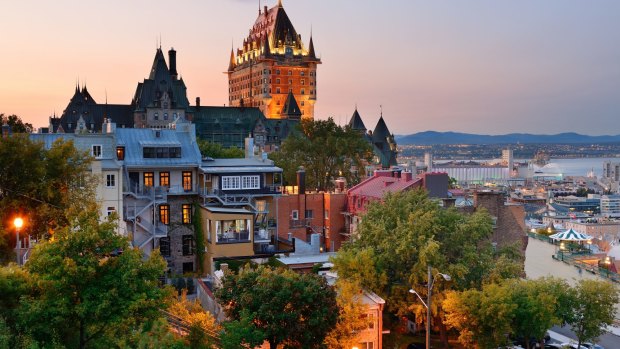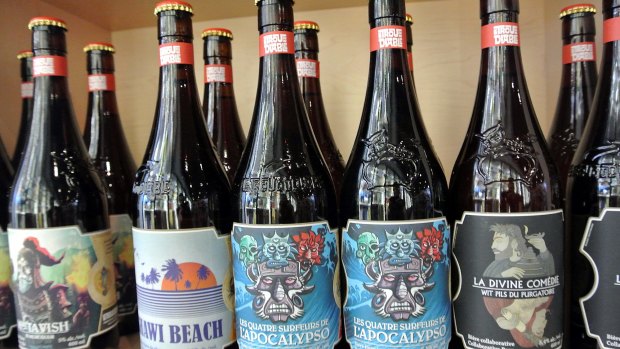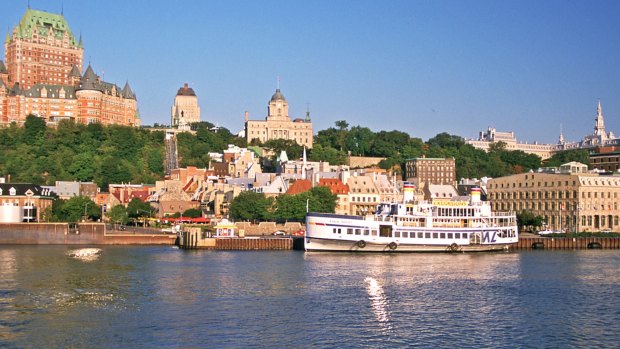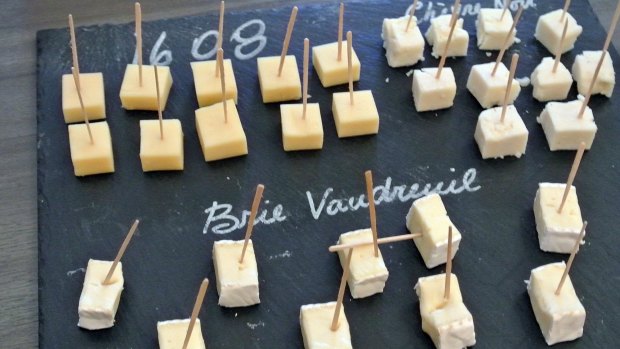This was published 7 years ago
Food travel guide to Eastern Canada: Where to go for beer, wine, cheese and maple syrup in Canada

The fairy-tale-like Chateau Frontenac casts its spell over Quebec City.Credit: iStock
It's a smidge after 8am when we arrive for breakfast at L'Erabliere du Lac Beauport, a rustic sugar shack and restaurant in the sleepy, forested Quebecois countryside.
Sugar shacks are ostensibly maple syrup farms where the sap collected from sugar maple trees is boiled into this sticky-sweet product, and we're welcomed by Richard Lessard, whose family have been in the maple syrup business since the 1850s. Sporting a red-checked lumberjack shirt, and a brown-tailed coonskin cap (a traditional Native American hat made from the skin and fur of a raccoon), Richard is a chirpy character, and, like many bilingual Quebecois, speaks English with a treacle-thick French accent.
"Are you hungry?" he asks, as he ushers our group into a slope-roofed cabin, where maple leaves drip from the ceiling, walls flaunt antique lamps, netted snow shoes and wood-carved moose heads, and the dining tables soon brim with help-yourself bowls of fried potatoes, home-cured ham, beans, scrambled eggs, pork rind and tourtiere (a ground meat pie that originates in Quebec). There are also jugs of maple syrup.

Eastern Canada craft beer.Credit: Steve McKenna
Fuelled by a "when-in-Rome" attitude – it's thought that 80 per cent of the world's maple syrup in produced in this Frenchified province – I fill my plate with a bit of everything and dribble syrup over it. Then I put syrup in my coffee. When we're done, the waitress delivers some crepes. I take a few and coat them in syrup. Then I have another syrupy coffee. And another syrupy crepe. Groggy earlier, the mood in our group is noticeably more alive – OK, sugar-rushed – and the upbeat Francophone folk tunes coming from the cabin's speakers seem to gather pace and volume. Tapping into the joie de vivre, Richard starts playing the (maple)wooden spoon – a traditional Quebecois folk instrument typically played at sugar shack get-togethers and heritage festivals.
"You hit it on the palm of your hand and thigh," he says, as a clip-clop sound, similar to that of the castanets in Spanish flamenco, fills the air. Wooden spoons are passed around our tables. Then there's a little competition to determine the best player. I learn I'm much more proficient at consuming syrup than "spooning".
Post-breakfast, we gravitate to the farm's main sugar shack as Richard talks us through the nitty-gritty of maple production, which dates back to the First Nations people (as Canada calls its indigenous) and usually peaks after the March-April harvest. The cabin's shop is stuffed with potential souvenirs, including syrup in maple-leaf-shaped bottles and maple-tinged butter, biscuits and herbal tea.

Eastern Canada Quebec City from the water.Credit: Steve McKenna
Richard then conjures a farewell gift: maple taffy. This ever-popular Canadian dessert is made by trickling boiling hot syrup onto a bed of crushed ice (or snow) and twisting the congealed candy, lollipop-like, on a stick. It's a saccharine way to end one of the high points of our seven-night Best of Eastern Canada Collette tour. Despite being the most populated half of the world's second-biggest country (home to 70 per cent of its 36 million people), Canada's east is often overshadowed by the west, as travellers – including the Duke and Duchess of Cambridge, and many Australians on gap-year working holidays – flock to, and rave about, Vancouver (frequently voted one of the world's most liveable cities) and the stunning natural beauty and wilderness of Whistler, Banff and Jasper national parks.
But while perhaps less dramatic visually, the east, we find, has oodles to write home (or Instagram) about, both in its buzzing cosmopolitan cities and idyllic, gently rolling countryside. For a large part, our tour skirts the St Lawrence River, a history-soaked waterway linking the Great Lakes with the Atlantic Ocean.
Once dominated by the indigenous Iroquois people, the river carried many of Canada's first European navigators, including Jacques Cartier, a Breton sailor who arrived in 1534, sowing the seeds for "New France", and sparking centuries of turf and trade wars with colonial rivals, Britain. One of the most photogenic areas of Montreal, the city where we kick off our tour, is Place Jacques Cartier.

Quebecois cheese tasting.Credit: Steve McKenna
Sloping down to the waterfront from Nelson's Column (a statue erected in tribute to the esteemed British general, Admiral Lord Nelson), this public square is characterised, in the warmer months at least (and temperatures hover around 30 degrees for most of our August trip), by vibrant Parisian-style terrace cafes and bistros, flower sellers, caricature artists and street performers, with its adjoining side streets lined with steakhouses, microbreweries, artisan shops, sculptures and galleries (many of which occupy rejuvenated port warehouses).
We discover more of Montreal's charms with Martine Cuillerier, who leads an absorbing foodie-themed walking tour of this, Quebec's largest city (where the main language is French, but almost half the residents can communicate in English). As well as trying maple ice-cream from sleek boutique Delices Erable et Cie, we sample a selection of Quebecois cheeses (including chevre noir – a truly delicious cheddar made from goat's milk) in Espace Europea, a snack-bar eatery owned by renowned Montreal chef Jerome Ferrer.
"We produce about 350 different types of cheese in Quebec," says Martine, who explains that, unlike their (French) cousins across the Atlantic, Quebecois are just as likely to pair cheeses with beer as wine. "We definitely have more of a beer-making tradition here. Our climate is more suited to it. Quebec struggles to make great wine because of the long, harsh winters, and traditionally only the rich could afford to import wine."
They do, however, make wine in Quebec (a province slightly smaller than Queensland). A few days later, I'm sipping a locally produced vin rouge, made from cold-hardy hybrid grapes, in Le Moulin St Laurent, a quaint restaurant set in a converted 18th-century flour mill on Ile d'Orleans, a gloriously pastoral, vine-matted island in the St Lawrence River just outside Quebec City. Although the wine goes well-ish with dinner – pate with caramelised onions and blackcurrant, wild game stew (bison, elk and venison), and maple sugar pie – I won't take any home (not least because, later in our trip, we'll go south to Ontario's Niagara Peninsula, whose relatively mild microclimate and mineral-rich soils have spawned a bounty of globally lauded wineries).
Adored by painters and poets, Ile d'Orleans isn't just a lovely getaway. As our coach driver, Pierre, navigates its serpentine country roads, driving past clapboard riverside mansions, farms built by early French settlers and lush fields dotted with grazing cows, our tour manager, Russ Gaudet, reveals its historical significance: it was on this island that British armies camped prior to wrestling Quebec City from French rule in 1759. "Quebec's motto is 'Je me souviens'," says Russ. "It's even on its car registration plates. It translates to 'I remember', but it basically means 'I remember my culture, language, history and the fact that the British colonised us'."
Despite this provincial pride, Quebec has no great appetite to leave largely anglophone Canada (at the last independence referendum, in 1995, voters opted for the status quo by a 1 per cent margin). In any case, Quebec City still feels more Saint-Malo than Southampton, particularly in its fortified old quarter, which is surrounded by 4.6 kilometres of walkable ramparts (built by the British, who, having usurped France, feared an invasion from the newly independent United States of America).
Strolling around the labyrinthine cobbled lanes with guide Tony Gagnon, I'm struck by the scent of cheese and freshly baked bread, the raspy voice of Edith Piaf soaring from a cellar bar, and French chatter between staff from a neighbouring boutique and bistro. We pause at Place Royale, a little square fringed by pretty stone buildings, including North America's oldest stone church (constructed in 1688, 80 years after Samuel de Champlain established the city).
"American movie-makers often come here when they need a European-looking backdrop," says Tony, "Catch Me If You Can was shot here, when Leonardo DiCaprio's character was captured in a French village."
The next day, before lunching at Saint Amour, a chic fine-dining restaurant in old Quebec, my fellow tourists see Michael Douglas and Catherine Zeta-Jones shuffling out of a brasserie (I miss them; I'm snapping photographs of a street that looks fabulously Parisian). But I'm not surprised. Celebrities have been flocking to Quebec City since the late 19th century, following the opening of Le Chateau Frontenac, a romantic clifftop hotel that's become Quebec's postcard icon.
We're staying just outside the old city in a slick modern Hilton. And every time I look out of my 12th-floor window – and see the turrets of Le Chateau, those magnificent ramparts, the St Lawrence River in the background – the phrase "Je me souviens" comes to mind. This is a view – and a trip – I won't forget in a hurry.
TRIP NOTES
GETTING THERE
Air Canada flies from Sydney and Brisbane to Montreal and Toronto via Vancouver. Flying from Melbourne requires a change in Sydney.
MORE INFORMATION
TOURING THERE
Running from April to November, with 37 tour dates in 2017, Collette's eight-day Best of Eastern Canada tour includes two-night stays in Montreal, Quebec City and Toronto, one night in Ottawa, a visit to Niagara Falls, and 11 meals. It's priced from $2329; gocollette.com.
Steve McKenna was a guest of Collette
FIVE MORE HIGHLIGHTS OF A COLLETTE EASTERN CANADA TOUR
TOUR SAINT-ANNE-DE-BEAUPRE
Just outside Quebec City, this grand basilica is one of the oldest pilgrimage sites in North America, a shrine to St Anne, Quebec's patron saint. Its engraved copper doors were made by the late Quebec-based French craftsman, Albert Gilles, whose family run a copper boutique and museum nearby; albertgilles-copper-art.com.
OTTAWA
We bus it around Canada's underrated capital, taking in its imposing civic buildings (notably the national parliament) and cutting-edge modern landmarks such as the sinuous-shaped Canadian Museum of History. Then we dine at ByWard Market, a hip hub of bars, eateries and speciality stores; byward-market.com.
NIAGARA FALLS
After scanning the world's most famous waterfalls from above, our poncho-clad group boards the Hornblower, a boat that gets awe-inspiringly close to the falls, letting you feel the spray and hear the thunderous roar; niagaracruises.com.
THOUSAND ISLANDS
A more sedate voyage is had on this picturesque section of the St Lawrence River, which is speckled with more than 1000 verdant islands on the US-Canadian border. We drift past eye-catching sites such as Boldt Castle, a fanciful estate built in 1900 by the original owner of New York's Waldorf Astoria Hotel; visit1000islands.com.
TORONTO
Few areas of Canada's largest city have changed more in recent years than its waterfront. Strolling along a promenade that hugs Lake Ontario, we find contemporary art galleries, craft breweries and exhibition spaces flourishing in a post-industrial setting. Then we admire the city's cloud-piercing skyline on a harbour cruise; seetorontonow.com.
Sign up for the Traveller Deals newsletter
Get exclusive travel deals delivered straight to your inbox. Sign up now.